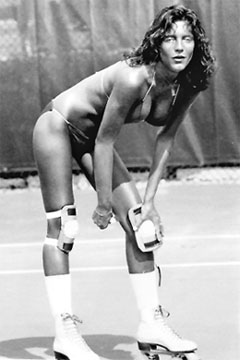|
| Magriel's NYT Columns |

Leslie Stone, a backgammon hottie
in addition to being a good player. The Black and White Boston Classic, held last weekend in Cambridge, Mass., was won by 22-year-old Leslie Stone of New York. Miss Stone is not a newcomer to backgammon; indeed, she won her first tournament in Nassau when she was 11 years old. Her early training came from her father, Tobias Stone, the internationally recognized backgammon and bridge champion.
In the finals, Miss Stone defeated a formidable opponent, Mel Drapkin. He is considered one of Boston’s best all-round players, and has an impressive record in this annual event; he won it in 1978 and was a semifinalist last year. In other results: Allen Hodis and Todd Van der Pluym were semifinalists; William Bartholomay defeated Michael Senkiewicz in the consolation; and Robert Bishop won the last chance.
The diagrammed position occurred in the second game of the 23-point finals match between Drapkin (Black) and Miss Stone (White). Earlier, Drapkin had rolled 6-6, which put him far ahead in terms of a possible running game. The position, however, is not yet a race because Black has two men stranded on White’s bar-point (the 18-point). In fact, the only way Black can hope to move these men without giving White shots is to roll a medium-sized double (3-3, 4-4, or 5-5).
|
| Black to play 5-3. |
Drapkin realized that time was against him, so he decided to make a run for it immediately, and boldly played 18/15, 18/13.
|
|
|
In the actual game, White (Miss Stone) was surprised to see a double shot suddenly appear in front of her, and she impetuously doubled. Theoretically, without a closed board, it is hardly ever correct to double on such a 20-number shot. Drapkin accepted and White rolled a 5-4, missing both blots. Drapkin redoubled, Miss Stone passed, and Drapkin gained two points in the match. Drapkin won the next two games and built up a 6–0 lead, but then the luck changed and Miss Stone eventually won 23–15.
Rollout
 Tom Keith 2013 |
|
Money play Centered cube Black rolls 5-3 1296 games with VR Checker play: 2-ply Cube play: 3-ply Red |
| 5-3: | Game | G | BG | Equity | ||||
| 1 | 18/15, 18/13 |
W L |
.4917 .5083 |
.0216 .0873 |
.0001 .0025 | −0.0948 |

| (b) |
| 2 | 6/3, 6/1 |
W L |
.3927 .6073 |
.0265 .1265 |
.0001 .0055 | −0.4735 | (0.3787) | (a) |

|
|

